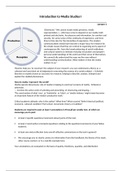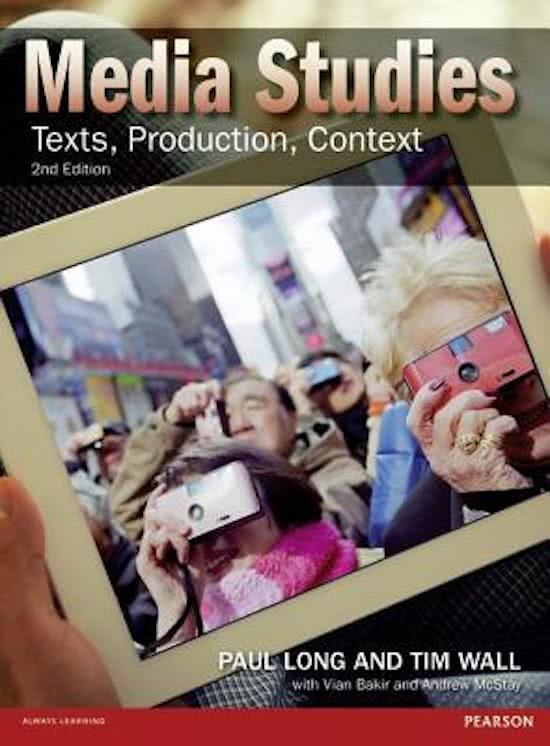IntroductonntonMedianStudiesnI
Lecturen1
Silverstone: “We cannot evade media presence, media
representatonn nnn] We have come to depend on our media, both
printed and electronic, for pleasure and informaton, for comfort and
security, for some sense of the contnuity of experience, and from
tme to tme also for the intensites of experiencen hhe modern
communicatons media have become a major focus for research for
the simple reason that they are central to organizing every aspect of
contemporary life, from the broad paterning of social insttutons
and cultural systems to intmate everyday encounters and people's
personal understandings of the world and their sense of themselvesn
We cannot fully understand the ways we live now without
understanding communicatonn What maters is that the media
maters to usn&
hheories help you 'to construct' the subject of your research: you can understand a theory as a
coherent and consistent set of judgements concerning the essence of a certain subjectn = Scholarly
theories or models chosen as source(s) for research, helping to describe, analyse, interpret and
explain the studied phenomenan
Howndonmedian'represent'nthenworld?
Media operate discursively: role of media in helping to construct versions of reality - fctonal or
otherwisen
'nnn involves the actve work of selectng and presentng, of structuring and shapingnnn'
'hhe constructon of what 'race', or 'femininity', or 'Islam', or 'media violence' might mean becomes
an important feature of the media's productve workn'
Critcal academic attude: who is the author What tme What country eefer historical (politcal,
economic, cultural) conditon art school, movement, theory or traditon
Studentsnarenrequiredntonpostnatnleastn5nannotatonsninnPerusallnpernweeklyntext,nofnwhichnwen
encouragenyountonpost:n
at least 2 specifc uestonsscomments about (parts of) the text;
at least 2 constructve commentss uestons relatng to the uestonsscomments of your fellow
students;
at least one meta-refecton (one overall refectve commentary on the text in general)
We encourage you to clearly connect to informaton from the Handbook, the theme of the week,
other course content, or to a real-life example heren
Your annotatons are evaluated on the basis of uality, tmeliness, uantty, and distributon
,You can start a new annotaton thread in Perusall by highlightng text, asking a ueston, or postng a
comment; you can also add a reply or comment to an existng threadn Each thread is like a chat with
one or more members of your classn
Seminarn1
On the mediaton of everything: defnitons diier between cultures in on mediaton textn Macro is
media systemn Micro is individualizedn Childhood is important because of her work feldn
Lecturen2
Interpret and understand ( ualitatve) = heurmenotcs vsn … ( uanttatve)
Interpretatie: how do media make meaning (Who uses ‘power’ over what processes of ‘self-
formaton’ in what ways on a politcal, economic and symbolic level) Who: individual using agency or
structuring social factorsn Study by what uestons and which concepts, theories, ideas and methodsn
Which intervening part do media, makers and users play in this process
Selfnandnexperienceninnanmediatednworldn–nJohnnB.nThompsonn1995
Making meaning: media have a symbolic dimension, the self as a ‘symbolic project’ we are the
biographers of our self as ongoing contnuous process with the media aiectng the process of self-
formatonn
'If 'man is an animal suspended in webs of signifcance he himself has spun', as [Clifordd Geertz once
remarked, then communicaton media are spinning wheels in the modern world and, in using these
media, human beings are fabricatng webs of signifcance for themselves.'
Thompsonnarguesnthatn'withnthendeielopmentnofnmodernnsocietes,nthenprocessnofnself-formatonn
becomesnmorenrefexiienandnopen-ended.'n
What does hhompson mean by this statement, and how do media play a role in this development
How do the diierences between modern and pre-modern societes as well as the refexive nature of
identty constructon relate to this refexive = react on
1n Explainnconcepts:
Self-formaton: self as symbolic project with us being actve constantly writng of identty with
(mediated, media to get access) symbolic materials (media as an example)
Modern societes: diierence between modern and pre-modern societes = before and af er the
development of modern communicaton median He talks mostly from the second half of the 20 th
century, he talked about when it developedn Before: face-to-face, less opportunites to travel and
gain informaton, horizon was smallern Af er: knowledge gathering opened up, not dependent on
face-to-face, not only informaton from dominant insttutons (less dependent local authorites)n
More refexive and open-ended: process of self-formaton and symbolic materials have always
been there, but now mediated and more available and more actven
2n In modern societes, the process of self- formaton is more refexive and open- ended, the
greater expansion of mediated symbolic material creates new opportunites for self-formaton
and re uires new demands of the self on a larger scale than beforen
MEDIA: Middle to transfer something, in the middle, necessary innbetweenn
, Intermediarynor mediatorn
Structuresnthenformnandncontentnofn'mediated'n
Interacton/ncommunicatonn
Medianasnformsnofn'symbolicnpower'n
to 'construct realites'
insttutonalized in society
technology, economy, policy
unevenly divided ('partcipaton')
historically specifc contexts (engn mass media, network- media)
Structuringnrolenofnthenmedianneffects:
Communicatonnmedianmakenrefexiienandnnon-localnorganisatonnofn'thenself'npossible,nbutnthesen
newnpossibilitesnalsoncreatennewnresponsibilites,nandnpositie/negatieneffects:n
hhe intrusion of ideological messages
'Double bind' of media dependency the more the self is 'enriched' the more it is dependant of
media
Symbolic overload too much mediated symbolic material = disorientng eiect
consider how people cope with this (see engn study Janice eadway, Reading the Romance)
hhe absorpton of the self (intmacy at a distance & non-dialogical (mediated uasi-interacton
(we now have other types of interacton like one sided interacton with a pop-star)) too
dependent and absorbed
engn self-help groups for chatng overload
Medianandnidentty:
Identtynisnnotniniariablyngiien,nbut:
Narratve constructon of the self, based on symbolic mediated material 'symbolic project'
Identty as coherent narratve, constantly re-constructed and re-defned
Identty changes depending on social structures and new experiencesn
Identtynisnnotnonlynproducednbynexternalnsystemsn
'We are all the unofcial biographers of ourselves, for it is only by constructng a story, however
loosely strung together, that we are able to form a sense of who we are and of what our future
may be.' - John Bn hhompson 1995, pn 210n
Farewell Facebook clip: how do people construct their identtes on the internet, media stmulate to
in some way construct your identty as a ‘story’ and use and show media as sources of identty
digital suiciden Media as in between, role media process identty structure, symbolic materialn
Thenstructurenis.nagencyndebaten–nblacknliiesnmater,nkendricknlamarnandnthenwire
Media as structures: insttutons, economy, technology and discoursen Media as potentalites for
acton and agency by the user: recepton, self-appropriaton and use constant negotatono
Dual role of media as consttuted by, as well as consttutng the formatonn






